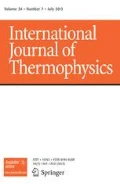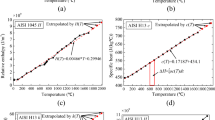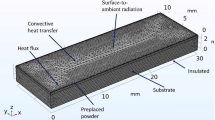Abstract
The geometry of the cladding pass cross section cannot be easily predicted in laser melting deposition. Due to the huge difference between the actual and the predicted cross section, it is difficult to conduct numerical simulations. In this paper, the finite element method (FEM) with thermal–mechanical coupling is performed. A novel cladding pass cross section model, isosceles trapezoid model, is proposed. The comparisons between the isosceles trapezoid model and the traditional model (disk model and rectangle model) are performed in terms of geometrical deviation, heat dissipation, temperature field, and stress field. The results show that the geometrical deviation and heat dissipation between trapezoid model and disk model is small, and that between trapezoid model and rectangle model is large. The trapezoid model has an additional degree of freedom for modeling, i.e., contact angle, which helps to conform complex cross section geometry more flexibility. The results of temperature field and stress field show that the deviation between the isosceles trapezoid model and the traditional models is small on the upper surface of the sample, and rectangle model has worse prediction results than the other two models at the interface between cladding pass and substrate. Finally, the validation experiment is carried out and the stress is measured by laser ultrasound technique. The experimental result matches the FEM result based on isosceles trapezoid model.












Similar content being viewed by others
References
R. Andreotta, L. Ladani, W. Brindley, Finite element simulation of laser additive melting and solidification of Inconel 718 with experimentally tested thermal properties. Finite Elem. Anal. Des. 135, 36–43 (2017)
A. Riquelme, P. Rodrigo, M.D. Escalera, J. Rams, Analysis and optimization of process parameters in Al-SiCp laser cladding. Opt. Lasers Eng. 78, 165–173 (2016)
D.D. Gu, B.B. He, Finite element simulation and experimental investigation of residual stresses in selective laser melted Ti–Ni shape memory alloy. Comput. Mater. Sci. 117, 221–232 (2016)
C. Lalas, K. Tsirbas, K. Salonitis, G. Chryssolouris, An analytical model of the laser clad geometry. Int. J. Adv. Manuf. Technol. 32, 34–41 (2007)
H. El Cheikh, B. Courant, J.Y. Hascoët, R. Guillén, Prediction and analytical description of the single laser track geometry in direct laser fabrication from process parameters and energy balance reasoning. J. Mater. Process. Technol. 212, 1832–1839 (2012)
V. Fallah, M. Alimardani, S.F. Corbin, A. Khajepour, Temporal development of melt-pool morphology and clad geometry in laser powder deposition. Comput. Mater. Sci. 50, 2124–2134 (2011)
S. Paul, R. Singh, W. Yan, I. Samajdar, A. Paradowska, K. Thool, M. Reid, Critical deposition height for sustainable restoration via laser additive manufacturing. Sci. Rep. 8, 1–8 (2018)
G. Palumbo, S. Pinto, L. Tricarico, Numerical finite element investigation on laser cladding treatment of ring geometries. J. Mater. Process. Technol. 155, 1443–1450 (2004)
C. Zhang, L. Li, A. Deceuster, Thermomechanical analysis of multi-bead pulsed laser powder deposition of a nickel-based superalloy. J. Mater. Process. Technol. 211, 1478–1487 (2011)
P. Peyre, P. Aubry, R. Fabbro, R. Neveu, A. Longuet, Analytical and numerical modelling of the direct metal deposition laser process. J. Phys. D Appl. Phys. 41, 025403 (2008)
M. Labudovic, D. Hu, R. Kovacevic, A three dimensional model for direct laser metal powder deposition and rapid prototyping. J. Mater. Sci. 38, 35–49 (2003)
J.C. Heigel, P. Michaleris, E.W. Reutzel, Thermo-mechanical model development and validation of directed energy deposition additive manufacturing of Ti-6Al-4V. Addit. Manuf. 5, 9–19 (2015)
K. Salonitis, L. D’Alvise, B. Schoinochoritis, D. Chantzis, Additive manufacturing and post-processing simulation: laser cladding followed by high speed machining. Int. J. Adv. Manuf. Technol. 85, 2401–2411 (2016)
P. Michaleris, Modeling metal deposition in heat transfer analyses of additive manufacturing processes. Finite Elem. Anal. Des. 86, 51–60 (2014)
X. Lu, M.J. Luo, M. Zhao, Z.Z. Shan, Thermal coupling analysis of lightning strike laminates. J. Aeronaut. Mater.s 40, 35–45 (2020)
Q.H. Guo, B.S. Du, G.X. Xu, D.G. Chen, L.C. Ma, D.F. Wang, Y.Y. Zhang, Influence of filler metal on residual stress in multi-pass repair welding of thick P91 steel pipe. Int. J. Adv. Manuf. Technol. 110, 2977–2989 (2020)
Y. Jiang, S.T. Wei, P. Xu, Influences of filling process on the thermal mechanical behavior of composite overwrapped pressure vessel for hydrogen. Int. J. Hydrogen Energy 45, 23093–23102 (2020)
L.L. Wan, L. Li, Z.H. Deng, W. Liu, Thermal-mechanical coupling simulation and experimental research on the grinding of zirconia ceramics. J. Manuf. Process. 47, 41–45 (2019)
J. Goldak, A. Chakravarti, M. Bibby, A new finite element model for welding heat sources. Metall. Trans. B 15, 299–305 (1984)
L.M. Dong, J. Li, C.Y. Ni, Z.H. Shen, X.W. Ni, Evaluation of residual stresses using laser-generated SAWs on surface of laser-welding plates. Int. J. Thermophys. 34, 1066–1079 (2013)
M. Hayes, R.S. Rivlin, Surface waves in deformed elastic materials. Arch. Ration. Mech. Anal. 8, 358–380 (1961)
Y. Pao, W. Sachse, H. Fukuoka, Acoustoelasticity and ultrasonic measurements of residual stresses, in Physical Acoustics, vol. 17, ed. by W.P. Mason, R.N. Thurston (Academic Press, New York, 1984), pp. 61–143
Y. Zhan, C. Liu, J.J. Zhang, G.Z. Mo, C.S. Liu, Measurement of residual stress in laser additive manufacturing TC4 titanium alloy with the laser ultrasonic technique. Mater. Sci. Eng. A 762, 138093 (2019)
T. Mukherjee, W. Zhang, T. DebRoy, An improved prediction of residual stresses and distortion in additive manufacturing. Comput. Mater. Sci. 126, 360–372 (2017)
Acknowledgements
This study is supported by the National Natural Science Foundation of China Project (Grant No. 51771051).
Author information
Authors and Affiliations
Corresponding author
Additional information
Publisher's Note
Springer Nature remains neutral with regard to jurisdictional claims in published maps and institutional affiliations.
Rights and permissions
About this article
Cite this article
Zhan, Y., Zhang, E., Fan, P. et al. A Novel Finite Element Model for Simulating Residual Stress in Laser Melting Deposition. Int J Thermophys 42, 56 (2021). https://doi.org/10.1007/s10765-021-02810-3
Received:
Accepted:
Published:
DOI: https://doi.org/10.1007/s10765-021-02810-3




